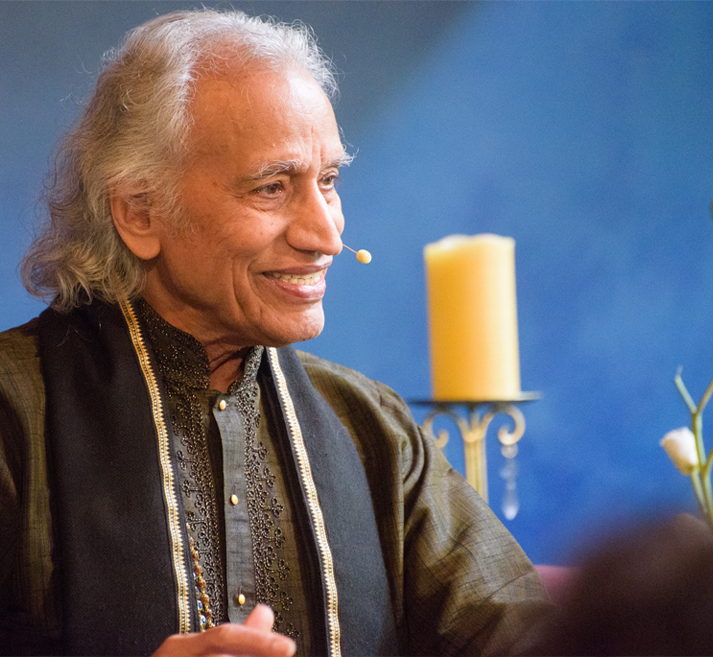The path of yoga is more than physical movement. It is a journey from doing to being, from effort to awareness. In the article below, Gurudev Shri Amritji shares how Hatha and Raja Yoga unite to unlock the deeper healing and spiritual transformation that yoga was always meant to offer.
Hatha Yoga and Patanjali’s Raja Yoga are two profound streams within the ancient yogic tradition. Understanding how they differ and how they can be integrated will empower your journey with clarity and direction. When combined through meditative awareness, they become a complete path for healing, awakening, and transformation.
Hatha Yoga is the path of embodiment. It begins with the body, not just as flesh and bone, but as a sacred vessel of consciousness. You use physical postures (asanas), conscious breathing (pranayama), and energy-balancing techniques to purify your inner landscape. This practice facilitates improved physical health, vitality, and internal balance, preparing your nervous system to handle deeper states of stillness. As you move through postures with awareness, your nervous system shifts from stress to restoration, opening the gateway to meditative stillness.
Through disciplined practice, Hatha Yoga strengthens your body, increases flexibility, and regulates your energy flow. But more than that, it trains your attention to stay present. The stress that accumulates in your body, often silently held as tension or emotional residue, begins to unwind through breath-synchronized movement. You notice that as you move with awareness, your mind begins to settle. This is the beginning of yoga: not the perfection of a posture, but the presence that pervades it.
Raja Yoga, the “Royal Path,” is the inward ascent. Its heart lies in the inner limbs: sensory withdrawal (pratyahara), one-pointed concentration (dharana), deep meditation (dhyana), and union beyond thought (samadhi). What makes Raja Yoga unique is its focus on mastering the mind. Instead of reacting to life through old patterns and emotional triggers, you begin to witness the mind’s movements. You become less entangled in its fluctuations and in this witnessing, you experience a profound inner stillness, a taste of your timeless Self.
With consistent practice, your identity shifts from the mind-made self to the eternal observer within.
When you combine the physical intelligence of Hatha Yoga with the meditative mastery of Raja Yoga, something extraordinary happens. You begin to heal at the root.
I AM Yoga is an integration of Hatha and Raja, body and mind, masculine witnessing and feminine energy. It is not about forcing your body into shapes. It is about being fully present in whatever posture or situation you find yourself, without resistance. You are no longer trying to change or perfect the body. You are becoming conscious of the old patterns stored in your body—and releasing them by meeting them with Presence instead of resistance. In I AM Yoga, this becomes your daily practice. Whether you are standing in a yoga pose or standing in line at the grocery store, you can embody the Posture of Consciousness, not just as something you do on the mat, but as a shift in your way of being.
When you face energy blocks in your body, whether it’s physical pain, tightness, or emotional discomfort, the ego mind wants to react. It wants to fix, fight, or flee. But Patanjali says: withdraw from the ego mind. Don’t resist the edge. Instead, witness it and stay with it. Let it reveal its root in emotional memory. As you practice in this way, you stop fighting the body and instead you start listening to it. You start partnering with the female parasympathetic energy body, your Prana Shakti.
Most of your suffering does not arise from the outer world but from how your mind, conditioned by emotional memory, reacts to it. These reactions stem from unprocessed energy blocks stored in the body. Formed through past traumas, unmet needs, or habitual reactivity, they keep you trapped in cycles of fear, anxiety, and separation. Science may diagnose symptoms, and doctors may treat effects, but rarely is the root, your identification with the time-bound ego mind, addressed or understood.
Patanjali was not presenting a philosophy; he was offering a method. The Yoga Sutras are not a theoretical framework but a practical guide to transformation. That’s why they doesn’t elaborate on complex postures or advanced physical practices. In Yoga Sutra 2.46, Patanjali gives only one instruction regarding asana: Sthira Sukham Asanam: your posture should be steady and at ease. This is not about perfecting the pose, but perfecting your presence within it. The body becomes a gateway to the stillness of the mind.
This is why in Yoga Sutra 1.2, Patanjali begins by defining yoga: Yogah Chitta Vritti Nirodhah: Yoga is the cessation of the fluctuations of the mind. He is saying: when you stop identifying with the movements of the mind, especially those rooted in memory stress, you begin to access the true Self that exists beyond all thought.
If you’re ready to go beyond technique and enter the deeper purpose of yoga, join us for the Inner Dimension of Yoga Retreat: I AM Yoga® Teacher Training, Part I. Guided directly by Gurudev Shri Amritji and Nirali Lauren McCrea, this immersive experience will train you in the true purpose of yoga—embodied meditation, energetic release, and awakening through Presence.
